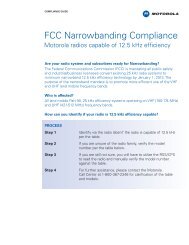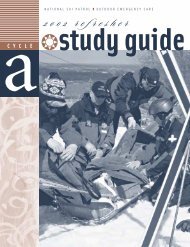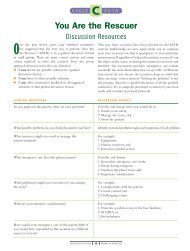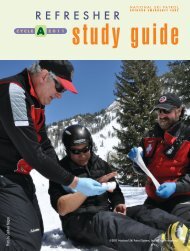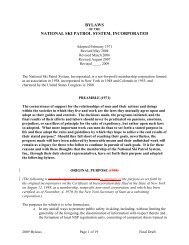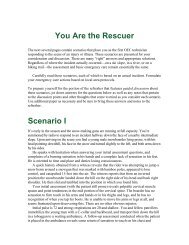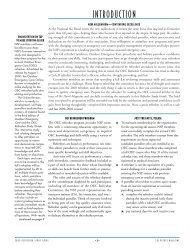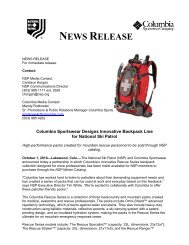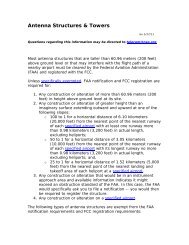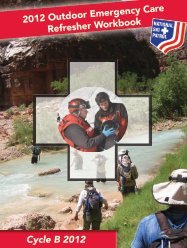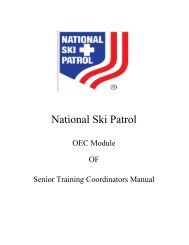Sierra Samaritans - National Ski Patrol
Sierra Samaritans - National Ski Patrol
Sierra Samaritans - National Ski Patrol
Create successful ePaper yourself
Turn your PDF publications into a flip-book with our unique Google optimized e-Paper software.
avalanche & mountaineering<br />
whelming need for better education and<br />
awareness of avalanche danger.<br />
THE LURE OF THE BACKCOUNTRY<br />
Perhaps due to crowded ski areas, long<br />
lines, boredom with the same old slopes,<br />
technological advancements in gear, commercial<br />
marketing of all things extreme, or<br />
the call of the pristine backcountry, a soaring<br />
number of winter enthusiasts in the<br />
past 15 years have taken to crossing beyond<br />
many a resort’s boundaries.<br />
A quick look at the average ski video<br />
of today compared to an older movie creates<br />
a dipstick for what today’s audience<br />
supports. The steep-and-deep flicks that<br />
draw cult-like followings don’t include<br />
much footage of inbound skiing at<br />
family-friendly resorts. Instead, big-name<br />
extreme competition champions are<br />
shown blazing new trails off vertical cliffs<br />
and down 60-degree slopes. These films<br />
seemingly reflect a cultural phenomenon<br />
within snowsports of touting one overarching<br />
concept: the more extreme the<br />
better. Adventurers in Europe and North<br />
America are answering the call of the<br />
wild; some of the individuals are experienced,<br />
some inexperienced. Some go with<br />
guides, some without.<br />
As ski resorts continue to expand and<br />
add new terrain, bigger, faster, and higher<br />
chairlifts take people closer to action that<br />
previously was only accessible to those<br />
willing to “earn their turns” with several<br />
hours or even days of backcountry touring.<br />
What was once out-of-reach is now at<br />
our skitips, and people are taking full<br />
advantage of the new terrain.<br />
Poaching—ducking under area boundary<br />
ropes to access off-piste terrain—has<br />
long been a concern for ski areas worried<br />
about the safety of their guests. However, in<br />
a lot of places in the United States, poaching<br />
is not illegal if ski areas are on and/or<br />
adjacent to state or national forest land,<br />
which is open to public use. Neither is it the<br />
patrol’s or the area’s responsibility to police<br />
those who would ski out-of-bounds at<br />
their own risk. Just as skiing in bounds<br />
presents risks for which the resort is not<br />
responsible, so does skiing beyond the<br />
area’s boundaries. The ropes are merely<br />
indicators of the boundaries of patrolcontrolled<br />
terrain. Still, resorts recognize<br />
the tendency for people to cross over those<br />
lines and have set up “access gates” as a way<br />
to funnel would-be poachers through a<br />
single point at which warning signs and<br />
information can be posted.<br />
Backcountry access gates at snowsports<br />
area boundaries allow people to<br />
explore off-piste terrain without committing<br />
to a several-day jaunt into the wilderness.<br />
You can spend the morning in the<br />
halfpipe or the back bowls, grab some<br />
afternoon freshies on the other side of the<br />
gate, and then return to the hotel hot tub<br />
and aprés-ski activities in the resort village.<br />
This adventurous trend is a good<br />
thing for the snowsports industry as a<br />
whole because it keeps the sports fresh<br />
and exciting. Unfortunately, problems<br />
arise when novices and, yes, even experts<br />
underestimate the danger and overestimate<br />
their qualifications.<br />
WHEN BAD THINGS HAPPEN TO<br />
POORLY PREPARED PEOPLE<br />
Snow scientist Peter Höller conducted a<br />
study of avalanche knowledge 15 years ago<br />
for the Austrian Institute for Avalanche and<br />
Torrent Research in Innsbruck. He drew up<br />
50 questions and distributed 500 copies of<br />
his questionnaire to two regional Austrian<br />
alpine clubs. Three significant findings in<br />
the study suggested that avalanche education<br />
in Austria needed to reach a broader<br />
group, particularly those headed to the<br />
snowy outback.<br />
Höller found that 1) a mere 19 percent<br />
of the ski mountaineers who participated<br />
in the study had any formal<br />
avalanche instruction; 2) only 60 percent<br />
of ski mountaineers regularly participated<br />
in avalanche beacon training or refreshing;<br />
and 3) most of the respondents didn’t<br />
even realize high avalanche danger exists on<br />
north-facing slopes! The investigation<br />
drove home the fact that just because a<br />
backcountry enthusiast had first-class skiing<br />
and guiding skills didn’t mean the<br />
individual had the necessary avalanche<br />
awareness education.<br />
Höller’s immediate recommendations<br />
were to address and reduce these problems<br />
by offering more precise details on hazard<br />
management via public service announcements<br />
on TV and using radio weather<br />
broadcasts that actually mentioned the<br />
word “avalanche.” Seasonally his organization<br />
and numerous others worldwide offer<br />
free classroom seminars and/or nominalfee<br />
avalanche field courses that are formally<br />
advertised and open to everyone. A parallel<br />
icon in the international avalanche industry<br />
is Bruce Tremper, director of the Utah<br />
Avalanche Forecast Center.<br />
Since Höller’s initial research, the<br />
snowsports community has experienced<br />
growing involvement in backcountry<br />
activity. However, despite the efforts of<br />
Höller, Tremper, and others there remains<br />
a major problem: Avalanche accidents<br />
have not decreased in Europe or America.<br />
In fact, fatalities in North America are<br />
still on the rise. The number of U.S. avalanche<br />
fatalities in 2003–04 (34) compared<br />
to 20 years earlier in 1983–84 (14)<br />
and 30 years earlier in 1973–74 (5) suggest<br />
more people are traveling and dying in the<br />
backcountry. Another study conducted in<br />
Austria during the 1999–2000 season<br />
showed a few positive changes, but none<br />
that would suggest backcountry accidents<br />
were less common or less likely to occur<br />
than a decade earlier. In 1990, for example,<br />
about 33 percent of the backcountry<br />
skiers surveyed had little or no idea about<br />
the processes that affect snowpack. In<br />
2000, that number dropped only slightly<br />
to 25 percent. Clearly, the increase in education<br />
and awareness doesn’t match the<br />
increase in activity.<br />
In the years since Höller conducted his<br />
research, there have been numerous developments<br />
in avalanche technology and<br />
tools. For European skiers and ’boarders<br />
the daily avalanche rating is traditionally<br />
found at the ticket office and posted on all<br />
major resort trail map marquees with<br />
flashing lights that visually inform skiers<br />
CONTINUED<br />
W inte r 2005 | <strong>Ski</strong> <strong>Patrol</strong> Magazine 49



